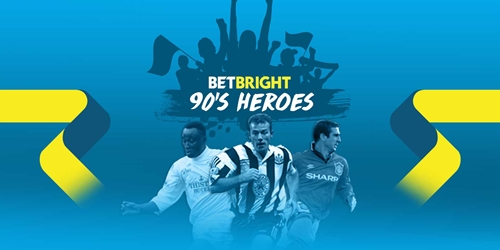’90s Heroes is a new series by Adam Hurrey on the Bet Bright football blog which looks back on the legends of the game in what now seems a simpler time for football.
Georgi Kinkladze to Boca Juniors. Georgi Kinkladze. Boca Juniors. Kinkladze. Boca.
The precise circumstances in which the then 20-year-old – and newly-crowned Georgian Player of the Year – turned up to wear the blue and gold, 8000 miles away from his parent club Dinamo Tbilisi, are not entirely clear. Throw in a bloody coup d’état back home and an abortive trial with Real Madrid, and Kinkladze’s career was already off to a fascinating start.
Having turned European heads with 42 goals in 65 games for Dinamo – in between the curious evacuations to Madrid, Buenos Aires and FC Saarbrücken, where Tony Yeboah had previously shone – Kinkladze’s prodigious talents needed a wider audience. His freewheeling national team, and their unsuccessful attempt to qualify for their first tournament as an independent nation, proved to be the showcase.
Having already masterminded a camera-friendly 5-0 win over Wales in Tbilisi (Neville Southall’s exponentially increasing disgust with every lob over his head really is worth a minute of your time) Kinkladze and co arrived in Cardiff for the reverse fixture. Proud Welshman Vinnie Jones belted out Hen Wlad Fy Nhadau, introduced his studs to Mikhail Kavelashvili’s groin to earn a red card after less than half an hour, and that created a little more space for Kinkladze to complete Southall’s misery with a effortlessly disguised chip that would become his calling card. The ball-boy’s reaction behind the goal perhaps said it all:
Just as clubs across the continent started to make their enquiries, one English chairman proved more decisive. Seduced by a burgeoning video showreel, Franny Lee secured Manchester City first refusal on the 22-year-old and, £2m and a work permit appeal later, Kinkladze became one of the most adventurous imports the Premier League had seen so far.
At this point, we really ought to be looking back at a decade or so of talismanic performances, putting Kinkladze on the same Premier League pedestal as Eric Cantona or Dennis Bergkamp. But that’s not how cult figures operate. For better or worse, Kinkladze’s Manchester City career fits quite comfortably into nine minutes and forty-one seconds.
Even allowing for the flourishes of amateur video-editing, this is a reassuringly relentless stream of undefendable hip-swerving and the almost cruel twisting of mid-1990s cloggers into a knot of limbs and polyester. It’s perhaps fitting that much of the material consists of meandering, impossible-looking journeys that often fizzle out into almost nothing except the tantalising thought of what might have been.
Even the way Kinkladze moved suggested it wasn’t ever likely to be a long-term love affair. An elegant square of a playmaker rather than a lithe ball-carrier, his physique didn’t lend itself to Premier League longevity in the way that, say, Thierry Henry’s did – although it did afford him the obligatory but unwieldy nickname of the Maradona of the Caucasus (a nickname that, like all the other geo-specific Diegos, no-one has ever actually said out loud.)
With his three-season shelf-life and a body designed for impudence only, Kinkladze perhaps set the template for a true Premier League cult figure. To qualify as such, you can’t be picking up Golden Boots every season, but you still need to offer more of a legacy than Marco Boogers (1 late tackle, 1 apocryphal caravan, 450 appearances in Worst Signings Ever lists).
Thankfully, Kinkladze was considerate enough to not only produce some unprecedented moments of blood-twisting skill, but also to make them fit into balletic seven-second social media video clips two decades later.
That City would be relegated twice in those three seasons of dummies, shuffles and nutmegs only serves to add to Kinkladze’s cult appeal. Within months of his gleeful alpine skiing through the Southampton defence, he was suddenly toying with Southend instead.
While a parallel universe of the little Georgian waving a reluctant goodbye to join Barcelona or Inter for some stratospheric success certainly has some romance to it, so too does the reality of being hacked out of a Division One game by David Hopkins (a player comparable to Kinkladze in the same way a fridge is comparable to a luxury yacht), crashing a Ferrari into a bridge, and having his mum flown over from Tbilisi to cook him a traditional Christmas dinner.
His intermittent, irresistible attacking flair came at the glaring expense of City’s defensive set-up. Various managers – six in all – indulged the diamond in their rough to the extent that he didn’t have to lift a defensive finger, to the point where teammates started to question his ultimate worth to the cause.
In 1998, with the pragmatic Joe Royle now in charge, and Kinkladze trotting out with suitable indifference for a fixture at Port Vale, City were headed for the Second Division. By then, it was abundantly clear that Kinkladze wasn’t the catalyst for an ambitious revolution like Juninho at Middlesbrough (albeit unsuccessfully) or Gianfranco Zola at Chelsea (rather more fruitful), rather an exotic gamble that paid fleeting dividends but left rather more valuable memories.
Ajax presented an attractive escape route from the third tier and the footballing agriculture that lay in store there, and a £4.9m move was swiftly agreed. Royle was rid of the player he regarded as “a negative” and City could begin their salvage operation. Still just 25, Kinkladze had plenty of time to write some compelling new chapters for his career – only to be forced to the periphery in Amsterdam, lose his sacred place in the national side, and suddenly find himself wondering where he would end up next.
The answer? Derby County. The Kinkladze highlights reel stalled further, thanks to injuries and more managerial upheaval: the dour Colin Todd had little time for diminutive playmakers with a laissez-faire attitude to tracking back.
Three years and 80 games went by with little to remark upon and, now 30, Kinkladze entered a rather less glamourous phase of his footballing existence. He found himself linked with trials and short-term contracts with Leeds, Dundee and Bolton – an unholy trinity of mid-2000s career resurrection projects – but his peak (an imperceptibly short moment somewhere between the despairing lunges of Southampton’s Ken Monkou and Dave Beasant) had been and gone.
Putting himself out to pasture, Kinkladze’s penultimate move – before retiring in Russia – was to join former international teammate Temuri Ketsbaia in Cyprus with Anorthosis Famagusta. It is here that we leave the Kinkladze story, one punctuated by tantalising video clips, with his final montage: 69 pixelated seconds, padded out by showing the same aimless dribble four times, all to the distinctly low-bitrate soundtrack of the official Champions League anthem.
There can be fewer more underwhelming final flourishes than that.
For the next instalment of ’90s Heroes, check out the Bet Bright football blog on Friday.







